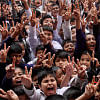Falling fertility and fading opportunity pushes Bangladesh at a demographic crossroads

A quiet demographic revolution is sweeping the globe: people everywhere are having fewer children. According to the UN's 2024 World Population Prospects, fertility rates have fallen below the replacement level of 2.1 children per woman in every region except Africa. In Asia, most countries have already crossed this threshold; some—like China, Japan, South Korea, and Thailand—are now losing population as deaths outnumber births. What was once a looming crisis for wealthy Western nations has become a global reckoning. Even Elon Musk has warned that falling birth rates could imperil civilisation's future.
For now, Bangladesh stands on the more fortunate side of the fertility divide. Over the past five decades, its fertility rate has declined from more than six children per woman to just above replacement level, where it has remained stable since 2011. This sharp decline—driven by family planning, reduced child mortality, rising female education, and shifting social norms—has placed our country in a demographic transition. With a youthful population and an expanding labour force, the country is poised to reap the so-called demographic dividend: a period when the share of working-age citizens is high, creating a one-time opportunity for rapid economic growth. So far, that promise remains unfulfilled.
The dividend is not automatic—it requires a healthy, educated, and productively employed workforce. Yet youth unemployment and underemployment are rising. Protests over civil service job quotas and the lack of opportunities for university graduates reflect a deeper structural mismatch between the skills and aspirations of the young and the economy's capacity to absorb them. Too many young people work in low-productivity, low-wage jobs, while large numbers in urban areas live in slums or on pavements in substandard conditions.
The experience of other countries offers inspiration and warning. East Asian economies such as South Korea and Taiwan successfully transformed their demographic windows into broad-based prosperity through investment in human capital and export-oriented industrial policy. By contrast, Egypt reduced fertility in the 1980s but failed to reform labour markets or reduce bureaucratic dominance, leaving youth unemployment high. Iran's fertility decline was undercut by sanctions and the underperforming private sector. Tunisia entered below-replacement fertility by the early 2000s but was hampered by structural rigidities and weak governance. The Arab Spring, sparked by street vendor Mohamed Bouazizi's self-immolation, was in part a demographic revolt—an explosion of frustration by a generation of educated but excluded youth.
Bangladesh risks a similar fate unless it acts decisively. Its working-age population is expected to peak in the mid-2030s. Without urgent reform, its demographic advantage could become a liability, manifested in a large cohort of disillusioned, underemployed youth, rising urban poverty, and an ageing population without adequate safety nets.
Yet, demography is largely absent from the nation's policy debates. Bangladesh's population and health policies have not been updated in over a decade. Although a new population policy is reportedly in draft form, it has yet to be released. Public investment in human capital remains stuck at around two percent of GDP for both education and healthcare, the lowest in South Asia.
Healthcare is grossly underfunded and deeply unequal. Rural areas face chronic shortages of trained personnel, supplies, and facilities. The rapid growth of private hospitals in cities offers neither universal access nor affordable care; their high costs often push families into debt. Out-of-pocket healthcare spending in Bangladesh is among the highest in the world. Medical education has not kept pace with demand: the country is not producing enough doctors, nurses, or specialists to serve its growing and ageing population.
The education system is similarly strained. Vocational and technical training is fragmented, underfunded, and poorly aligned with labour market needs. Universities still rely on rote memorisation over creativity, problem-solving, and practical skills. Despite gains in girls' education, female labour force participation remains low, constrained by social norms, lack of childcare, and workplace barriers.
Bangladesh's long-standing reliance on labour migration is also under pressure. Remittances from overseas workers have buoyed the economy for decades, but host countries are tightening immigration rules, adopting labour-saving technologies, and favouring skilled workers. The demand for low-skilled migrant labour is falling, and Bangladesh has done little to upgrade skills to meet changing global needs.
Vietnam shows what a proactive demographic strategy can achieve. By aligning its education system with industrial needs, expanding healthcare access, investing in technology, and integrating into global value chains, Vietnam has built a workforce capable of adapting to shifting demographic and economic realities.
Bangladesh can still follow a similar path, but the clock is ticking. Falling fertility can bring benefits—more resources per child, better maternal health, higher female labour participation, and greater capacity to prepare for an ageing society. Population ageing, often viewed as a looming crisis, can spur innovation in healthcare, caregiving, and labour-saving technologies. But these benefits are only realised with foresight and sustained investment.
What is needed now is a coherent, forward-looking demographic strategy. This includes scaling up public investment in both general and medical education, overhauling technical and vocational training systems, expanding access to quality healthcare, and removing structural barriers to female workforce participation. Equally essential is fostering an ecosystem for innovation and entrepreneurship, where young people are not merely job seekers but job creators.
Demographics are not destiny—but they define the playing field. The unrest over youth unemployment is more than an economic issue; it is a demographic alarm bell. Bangladesh's fertility transition is unfolding now (although stalled over the past decade), and its demographic window is already narrowing. Whether the country seizes this moment or squanders it will shape its economic and political trajectory for decades.
Dr M.G. Quibria is a development economist and former senior adviser at the Asian Development Bank Institute. He can be reached at [email protected].
Dr Barkat-e-Khuda is a former professor and chairman of Department of Economics at the University of Dhaka. He can be reached at [email protected].
Views expressed in this article are the author's own.
Follow The Daily Star Opinion on Facebook for the latest opinions, commentaries and analyses by experts and professionals. To contribute your article or letter to The Daily Star Opinion, see our guidelines for submission.


 For all latest news, follow The Daily Star's Google News channel.
For all latest news, follow The Daily Star's Google News channel. 










Comments